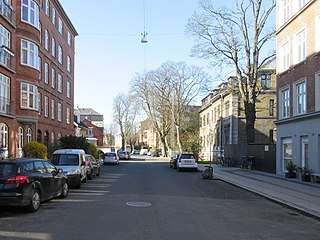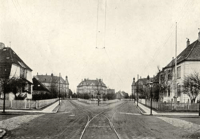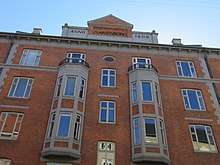Mariendalsvej
Mariendalsvej is a street in the Frederiksberg district of Copenhagen, Denmark. It runs from Falkoner Allé in the southeast to the Ring Line in the northwest. The area to the southeast of Nordre Fasanvej runs through the Mariendal Quarter and the rest runs through the Fuglebakken neighbourhood.
 | |
| Length | 1,340 m (4,400 ft) |
|---|---|
| Location | Copenhagen, Denmark |
| Quarter | Frederiksberg |
| Postal code | 1619, 1859 |
| Nearest metro station | Frederiksberg |
| Coordinates | 55°41′27.6″N 12°31′54.48″E |
| Southeast end | Falkoner Allé |
| Major junctions | Nordre Fasanvej |
| Northwest end | Ring Line |
History
.png)

The street takes its name after the country house Mariendal which was located close to the beginning of the street. The estate was acquired by the businessman Niels Josephsen in 1889. He lived in the main building but created a master plan for a new neighbourhood and sold the land off in lots. He paid for the construction of Mariendal Church out of his own pocket and gave a number of lots away for charitable housing projects or sold them at very favourable conditions.[1]
Notable buildings and residents

Hjem for arbejdsdygtige blinde Kvinder at No. 30 is from 1900 and was designed by David Wilhelm Leerbeck. Post- og Telegrafembedsmændenes Stiftelse at No. 38-40 is a charitable housing estate built to provide housing for Royal Danish Mail employees. It is from 1902 and was designed by Thorvald Bindesbøll. The building for female municipal primary school teachers from 1900 was designed by Anton Haunstrup. Stiftelse for Handelsrejsende at No. 36 is a charitable housing estate built for travelling salesmen. It is from 1949 and was designed by Arthur Wittmaack.
The building at No. 46 is the former headquarters of Henriques & Løvengreen's Trikotagefabrikker, a former manufacturer of knitted hosiery founded by Michael Henriques and Malmö-based Oluf Johannes and Gustav Løvengreen in 1897.[2]
Built in 1905 to design by Ulrik Plesner, Mariendalsvej 62-64 was built to provide housing for workers.[3]
The villa at Mariendalsvej 77 was designed by Hans Koch in collaboration with Carl Petersen for Harald Moltke in 1912. Hans Koch also designed Kristian Zahrtmann's villa at Kristian Zahrtmanns Plads 79 from 1913.
References
- "Frederiksberg, Mariendalsvejs stiftelser og Post- og Telegrafembedsmændenes Stiftelse, nr. 38-40". arkark.dk (in Danish). Archived from the original on 31 December 2017. Retrieved 25 July 2016.
- "Henriques & Løvengreen's Trikotagefabrikker A/S". coneliand.dk (in Danish). Retrieved 20 June 2019.
- "Frederiksberg, Mariendalsvej 62-64, Forsøgshusene". arkark.dk (in Danish). Retrieved 25 July 2016.